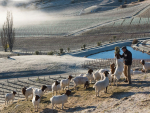Biosecurity progress and challenges for NZ winegrowers
Dr Ed Massey is General Manager Sustainability at New Zealand Winegrowers.
Increasing reports of weevil damage to vines in Marlborough, Hawke’s Bay and Wairarapa led researchers to ascertain the culprits.
Grape Days 2022 audiences heard about the one-year programme from Bragato Research Institute (BRI) Viticulture Extension and Research Manager Len Ibbotson, along with Scott Hardwick from AgResearch, and David Jordan from Vine to Wine. The scope of the project was to increase grower awareness, find out what weevil species are present in vineyards, estimate the current and future economic impact of weevil damage, and make a recommendation for next steps, says Len.
The research found that the main species present on vines in mature vineyards during the summer months appear to be garden weevil (Phlyctinus callosus), which was associated with chewing damage to leaves and bunches. “Adult garden weevil, having emerged from the soil, began appearing on vines during November to December and most of the chewing damage occurred during December and January,” he explains. The damage and incidence appears “patchily distributed within vineyards, with “hotspots” of high incidence and moderate to severe damage.
Fuller’s rose weevils (Pantomorus cervinus) were also seen in late summer and on fruit at the winery.
For more information go to nzwine.com/media/20546/bri-research-fact-sheet_weevilmonitoring.pdf

The end of the year is fast approaching, so here are some thoughts on a few of the significant developments…

OPINION: When I moved to Marlborough two decades ago, I found countless lines of tidy vines, neatly mowed and carefully…
The large 2025 harvest will exacerbate the wine industry's "lingering" supply from recent vintages, New Zealand Winegrowers Chief Executive Philip…
If you find a new consumer in a developed wine market, you are taking them from someone else, says Blank…
OPINION: Sauvignon Blanc was famously introduced to New Zealand by Ross Spence of Matua Valley, and then serendipitously planted in…